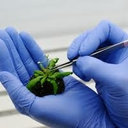Short communication: in vitro assessment of antioxidant, antibacterial and phytochemical analysis of peel of Citrus sinensis.
Cuvinte cheie
Abstract
Antibacterial effect of Citrus sinensis peel extracts was evaluated against several pathogenic bacteria associated with human and fish infections viz., Escherichia coli, Pseudomonas aeruginosa, Klebsiella pneumonia, Staphylococcus aureus, Streptococcus pyogenes, Staphylococcus epidermidis, Serratia marcesnces, Shigella flexneri, Enterobacter amnigenus, Salmonella Typhimurium and Serratia odorifera. Methanol, ethanol, chloroform and diethyl ether solvents were used for extraction. In vitro antibacterial activity was analyzed by agar well and agar disc diffusion methods. It was found that ethanol extract showed highly significant inhibition of E. coli and K. pneumonia (12.6±0.94 mm and 11.6±1.2 mm) whereas methanol extract of C. sinensis also showed high zone of inhibition of S. odorifera (10.0±2.16 mm). The potential activity of active extracts was assessed and also compared with standard antibiotics through activity index formulation. The order of antioxidant activity through ABTS·+ and DPPH free radical scavenging activity was ethanol>methanol>chloroform>diethyl ether. Phytochemical screening of all solvents had determined the presence of terpenoids, alkaloids, steroids, glycosides and flavonoids. It was also found that Chloroform/Methanol (5:5) and Butanol/Ethanol/Water (4:1:2.2) solvent systems showed significant separation of active phytochemical constituents. These findings reveal the potential use of C. sinensis peel to treat infectious diseases, which are being caused by microorganisms.



